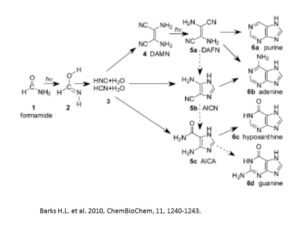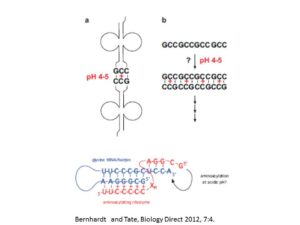アルカリ熱水孔における炭化水素とアンモニアの形成: Synthesis of Hydrocarbon and Ammonia at an Alkali Hydrothermal vent
かんらん岩などのマントル物質が高温の水と接触すると、蛇紋岩化反応が進行する(McCllom and Bach 2009; Bach et al. 2006)。
2Mg1.8Fe0.2SO4→Mg2.85Fe0.15SiO5(OH)4+Mg0.75Fe0.25(OH)2
かんらん岩 蛇紋岩 フェロブルーサイト
フェロブルーサイトは、さらに分解して
12Mg9.75Fe0.25(OH)2→Fe3O4 + 9Mg(OH)2 + H2 + 2H2O
フェロブルーサイト 磁鉄鉱 ブルーサイト
となる(McCllom and Bach 2009)。
その結果、水素ガスに富む強くアルカリに傾いた熱水(~150°C)が噴出する熱水孔が海底に形成される。このようなアルカリ熱水孔において、生体の原材料物質が合成されることがわかってきた(Russel et al. 2010)
このようなアルカリ熱水システムにおいて、二酸化炭素からの炭化水素形成はフィッシャー・トロプシュ型反応で進む。鉄・ニッケル合金は、フィッシャー・トロプシュ型反応を通して、海洋底地殻にあるCO2をC2からC4の炭化水素に変える(Proskurowski 2008)。ここで、金属鉄と鉄・ニッケル合金は、蛇紋岩化システムで期待される物質である(Krishnarao, 1964; Chamberlain et al., 1965; McCollom and Bach, 2009)。これらの金属触媒は、既に存在していた金属の硫化物が、還元的な流体の作用で生じたものである(Frost, 1985; Russell et al.,1989, 1994; Macleod et al., 1994; Delacour et al., 2008; Proskurowski et al., 2008; Klein & Bach, 2009)。また、磁鉄鉱はフィッシャー・トロプシュ型反応の効率の良い触媒である(Chen et al. 2000; Holm et al. 2001)。さらに、Foustoukos and Seyfried(2004)は、鉄とクロムの混合鉱物が炭化水素の合成を進めていることを発見した。
一方、N2からのNH3形成もアルカリ熱水系で起こる。Smirnov et al. (2008)は、熱水孔の再現実験(70℃、PH=6-7)において、金属の鉄(Fe0)が窒素の水素化の触媒として働くことを示した。また、Dorr et al. 2003は、FeSを触媒に、H2Sを電子源として使って、酸性条件(PH3-4)ではあるが、80℃でN2がNH3に変化することを確認した。
Russell M.J. et al. 2010, Serpentinization as a source of energy at the origin of life, Geobiology, 8, 355-371.
McCollom TM, Bach W: Thermodynamic constraints on hydrogen
generation during serpentinization of ultramafic rocks.
Geochim Cosmochim Acta 2009, 73:856-875.
Bach W, Paulick H, Garrido CJ, Ildefonse B, Meurer WP, Humphris SE: Unraveling the sequence of serpentinization reactions: Petrography, mineral chemistry, and petrophysics of serpentinites from MAR 15°N (ODP Leg 209, Site 1274). Geophys Res Lett 2006, 33:L13306.
Proskurowski G, LilleyMD, Seewald JS, Fru¨h-Green GL,Olson EJ, Lupton JE, Sylva SP, KelleyDS (2008) Abiogenic hydrocarbon production at Lost City hydrothermal field. Science 319, 604-607.
Chen QW, Bahnemann DW: Reduction of carbon dioxide by
magnetite: Implication for the primordial synthesis of
organic molecules. J Am Chem Soc 2000, 122:970-971.
Holm NG, Charlou JL: Initial indications of abiotic formation of hydrocarbons in the Rainbow ultramafic hydrothermal system, Mid-Atlantic Ridge. Earth Planet Sci Lett 2001, 191:1-8.
Foustoukos DI, Seyfried WE Jr: Hydrocarbons in hydrothermal
vent fluids: The role of chromium-bearing catalysts. Science
2004, 304:1002-1005.
Krishnarao JSR (1964)Native nickel-iron alloy, its mode of occurrence, distribution and origin. Economic Geology 59, 443-448.
Chamberlain JA, McLeod CR, Traill RJ, Lachance GR (1965)Native metals in the Muskox intrusion. Canadian Journal of Earth Science 2, 188-215.
McCollom T, BachW(2009) Thermodynamic constraints on hydrogen generation during serpentinization of ultramafic rocks. Geochimica et Cosmochimica Acta 73, 856-875.
Frost BR (1985)On the stability of sulfides, oxides and nativemetals in serpentinite. Journal of Petrology 26, 31-63.
RussellMJ, Daniel RM,Hall AJ (1993) On the emergence of life via catalytic iron-sulfidemembranes. Terra Nova 5, 343?347.
RussellMJ, Daniel RM,Hall AJ, SherringhamJ (1994) A hydrothermally precipitated catalytic iron sulphide membrane as a first step toward life. Journal of Molecular Evolution 39, 231-243.
Macleod G, McKeown C, Hall AJ, Russell MJ (1994)Hydrothermal
and oceanic pH conditions of possible relevance to the origin of life. Origins of Life and Evolution of the Biosphere 24, 19-41.
Delacour A, Fru¨h-Green GL, Bernasconi SM (2008) Sulfurmineralogy and geochemistry of serpentinites and gabbros of the Atlantis Massif (IODP SiteU1309). Geochimica et Cosmochimica Acta 72, 5111-5127.
Klein F, BachW(2009) Fe-Ni-Co-O-S Phase relations in peridotiteseawater interactions. Journal of Petrology 50, 37-59.
Do¨rr M, Ka¨sbohrer J,Grunert R, Kreisel G, Brand WA, Werner RA, Geilmann H, Apfel C, Robl C, WeigandWA(2003) Possible prebiotic formation of ammonia fromdinitrogen on iron sulfide surfaces. Angewandte Chemie International Edition 42, 1540-1543.
書籍版『科学はひとつ』のご案内
戎崎俊一 著
学而図書/四六判 並製320頁/本体2,400円+税
12年にわたり執筆されてきた記事を精選し、「地震と津波防災」など全9章に再編。すべての章に著者書き下ろしの解説を加えて集成した一冊。





